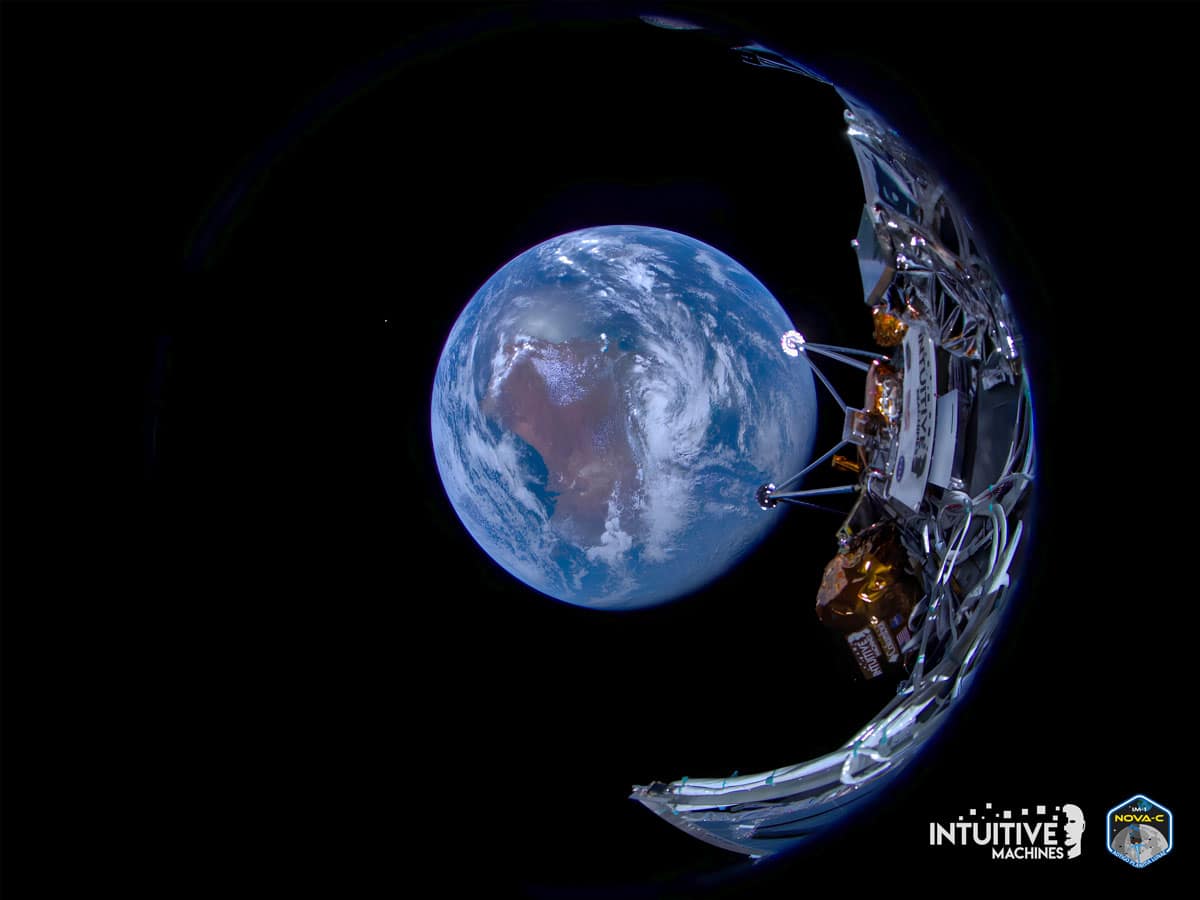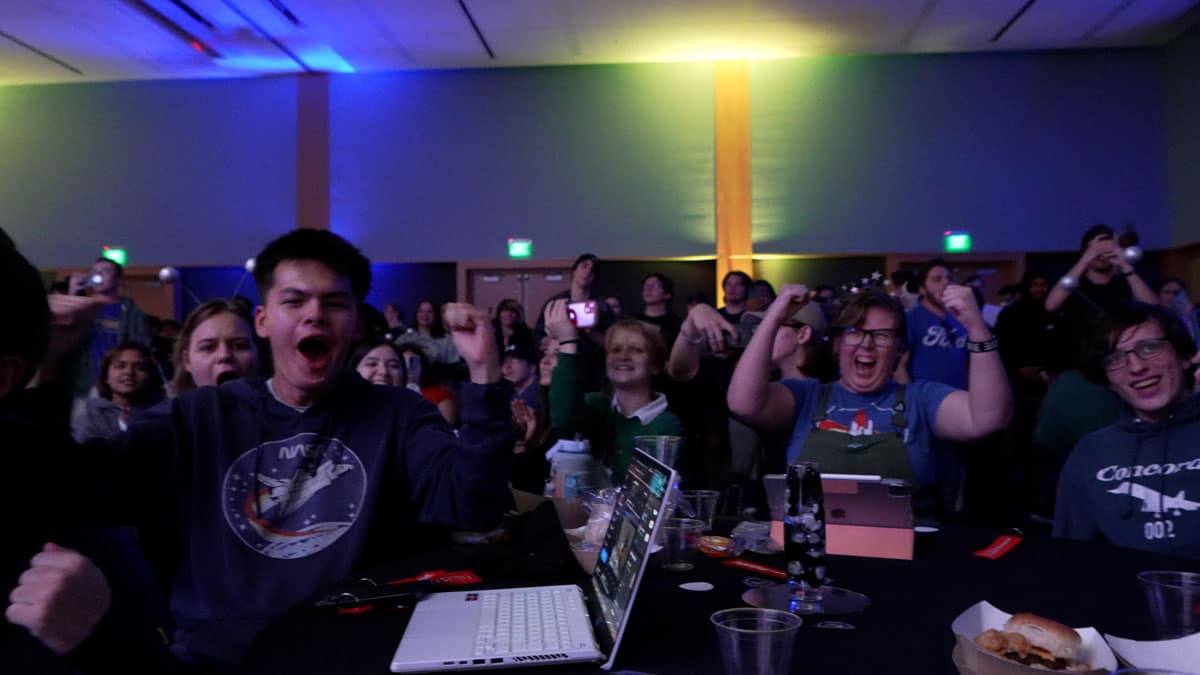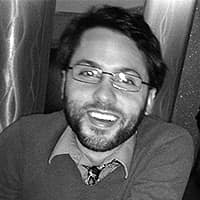Embry-Riddle Celebrates Historic Moon Landing

Cheers roared through the Mori Hosseini Student Union Thursday night, Feb. 22, at Embry-Riddle Aeronautical University, as students, faculty and staff watched Intuitive Machines’ Odysseus Nova-C class Lunar Lander touch down on the moon.
The event was historic, both for the United States — which celebrated its return to the moon for the first time since Apollo 17, in 1972, with the mission — and for the university, which had student-built hardware onboard.

EagleCam team members Taylor Yow and Grace Robertson stand next to a one-third replica model of Intuitive Machines’ Odysseus Nova-C class Lunar Lander. Robertson, who graduated in 2022, now works as a systems engineer for Sierra Space. (Photo: Embry-Riddle/David Massey)
After years of design, development and delays, “EagleCam” — the entirely student-built miniature camera system housed within a CubeSat — had finally landed.
“It almost feels surreal,” said Taylor Yow, an Aerospace Engineering graduate student and EagleCam project manager. “When we started this project, I was still an undergrad. Now it’s four years later, and this device that we invented is out there, on the moon!”
But the team’s work was not done yet.
As the lunar lander began its final descent onto the moon, the plan was for EagleCam to spring, literally, into action, ejecting from the spacecraft about 100 feet before touchdown to snap photos of the lander as it settled onto the lunar surface. After complications forced EagleCam to shut down during landing, preventing the ejection mechanism from triggering when initially expected, the EagleCam team had to pivot. For days, they worked tirelessly to adapt their mission plans and procedures in order to deploy its CubeSat camera system.
As Intuitive Machines’ CEO Steve Altemus explained during a Feb. 28 press conference, the EagleCam was reactivated and ejected safely, landing about four meters away from the lunar lander. As of this writing, the EagleCam has not returned an image, but the team continues to work on it, and Altemus described the project as a success.
“With respect to EagleCam — what an amazing team of faculty and students at Embry-Riddle Aeronautical University,” Altemus said during a video event captured on YouTube. “I think it’s a wild success. I would love to fly the EagleCam again. Those students put their heart into it and it’s a really innovative design.”
The EagleCam team was proud to have the first university, student-built payload on the moon. Although complications have currently resulted in an inability to acquire images, the team continues to work on it, as of this writing. Data collected during the mission will be analyzed and published to benefit future space missions.
“This was an incredibly ambitious project, from start to finish,” said Dr. Troy Henderson, director of Embry-Riddle’s Space Technologies Laboratory, where EagleCam was dreamed up and built from scratch. “I couldn’t be more proud of what these students accomplished.”
In addition to Henderson, faculty members working on the EagleCam project have included Dr. Eduardo Rojas-Nastrucci, associate professor in the Department of Electrical Engineering and Computer Science and director of the Wireless Devices and Electromagnetics (WiDE) Laboratory; Dr. M. Ilhan Akbas, associate professor in the Department of Electrical Engineering and Computer Science; and Dr. Jennifer Smith, professor in the Aerospace Engineering Department, as well as more than two dozen undergraduate and graduate students.

EagleCam faculty lead Dr. Troy Henderson (center) poses with members of the team (from left): Chris Hays, Daniel Lopez, Daniel Posada and Taylor Yow. (Photo: Embry-Riddle/Caroline Duda)
A First Time for Everything
History was made Feb. 22, 2024, about 239,000 miles away from Earth.
There, on the lunar surface, EagleCam set out to accomplish a series of firsts, which are listed as follows:
- Become the first-ever university student-built project to land on the moon.
- Capture the first-ever third-person image of a spacecraft touched down on the lunar surface.
- Use WiFi on the moon for data transmission.
EagleCam launched aboard a SpaceX Falcon 9 rocket in the early hours of Thursday, Feb. 15, 2024. After an eight-day journey to the moon’s south pole — which began when the lander deployed from the rocket after liftoff — the Embry-Riddle device arrived at its destination.
“There was always the possibility that something failed,” said Daniel Posada, an Aerospace Engineering doctoral student who served as a lead engineer on EagleCam. “But what is important is the work we did to get here.”
In addition to the team’s primary mission objectives, they also set out to test an electrodynamic dust shield — a device meant to electrically “shake” lunar regolith, or moon dust, off the EagleCam’s lenses — after landing. In the works since the Apollo era, the technology is meant as a proof of concept: If successful, the technology could, eventually, be developed further to be incorporated into spacesuits to improve astronaut’s mobility and visor visibility.
“Being able to say that this team came out of the classroom, applied what they’ve been learning in a whole variety of ways — from mechanical, electrical to software — and were able to successfully complete this project and deliver it, that in of itself is a great thing,” Henderson added. “Lots of these students have also already gone on to really good jobs for the reason that they have hands-on experience in the lab.”
Plus, the EagleCam project led to the creation of a new scholarship program at Embry-Riddle to support outstanding women in STEM. The “Intuitive Machines and Columbia Sportswear Advancing Women in Technology Program” provides funding and fellowships for both undergraduate and graduate students, and Yow was one of its first recipients.
“I would not have been able to pursue my dream without scholarships, awards and grants,” said Yow, who grew up in Niceville, Florida, and notes that her participation in the EagleCam project is what motivated her to pursue a master’s degree. “My parents joke that Undergrad Taylor and Grad Student Taylor are two different people – just because my confidence level has skyrocketed.”
Paying It Forward
By his own admission, Embry-Riddle alumnus Steve Altemus (’87) was “not a stellar student” and “struggled to get through engineering school.” Still, he stuck with it, earned his degree and spent the next 30 years building a successful career based on his love for space travel.
Then in 2013, he founded Intuitive Machines. A few years later, he posed a challenge to students at his alma mater: Build a CubeSat, and Intuitive Machines will take it to the moon.
“I’ve always been impressed by Embry-Riddle’s focus on hands-on development work for engineers,” Altemus said. “To have my own company and to be able to fly to the moon, I just felt like there had to be a way for my alma mater to participate.”
That’s how EagleCam was born, and Altemus sees the project today as a gateway for students to access the wonders, and vast career opportunities, available within the commercial space sector.
“If you can show someone what the future looks like in a very tangible way, it’ll change their life in positive aspects,” he said. “That’s what I see in their eyes and hear from their voices about the future of space. And I love to see that spark just appear, and now, suddenly, they’re awakened to all the possibilities of what a career in space exploration can be.
The EagleCam team met with Altemus personally last year, when a couple of members traveled to Intuitive Machines’ headquarters, in Houston, to integrate the device onto the lunar lander.
“Having the chance of working on a real project going to space is unique and challenging,” Daniel Lopez, a Mechanical Engineering student on the EagleCam team said, after the visit. “I could not be more grateful to the Space Technologies Lab for this opportunity.”
“The experience of working on a real-life project, with real flight hardware, doing real testing and development has been invaluable,” Chris Hays, another EagleCam team member, said. “Participating in this project has reinforced my desire to pursue a space-related career.”

Students, faculty and staff erupted into applause Thursday, Feb. 22, 2024, on Embry Riddle’s Daytona Beach Campus, to celebrate EagleCam’s arrival on the moon. (Photo: Embry Riddle/David Massey)
Lessons Learned
For teams forging into the “final frontier,” there is only one true certainty. Henderson states it simply: “Space is hard.”
“It’s hard because you’ve got the launch itself with the shock and vibration effects and high speed, then the space environment is insanely cold with radiation,” he added. “Part of it is just the unknown environment we have to operate in, and there is minimal room for any mistake.”
For the EagleCam team — which tracked its progress since 2020 on Instagram — embracing those unknowns was always the point.
“One of the most exciting things is that this is a real problem,” Posada said of the project. “First you have to know how the math works, but then there is the hands-on part, where you have to constantly test, design and iterate.”
“There are never any guarantees in space travel, and we knew that going in,” Yow added. “Mission complications don’t take anything away from the incredible experience we gained along the way. We put everything we had into this project, and it gave us more knowledge and experience than we ever could have learned from books.”
In addition to the scientific knowledge gained — “EagleCam should record enough data for Ph.D. students to analyze in dissertations for the next five years,” Henderson said — the team also got to collaborate closely with Intuitive Machines and SpaceX, network with industry leaders and gain invaluable in-the-field work experience.
“That kind of thing will be noticed by future employers,” Yow said. “We know we’re prepared for jobs in the field because we’ve already been working in the field since the start of this mission.”
Although the EagleCam project has come to an end at Embry-Riddle, the ripples of its impact on students’ lives and the data it will contribute to future space mission is just beginning.
“Working on EagleCam was the highlight of my academic career,” Posada added.
Dr. Jim Gregory, dean of the College of Engineering at Embry-Riddle’s Daytona Beach, Florida, campus said, “I’m deeply impressed by the innovation, dedication and creativity of the EagleCam team! The students and faculty have accomplished great feats, and we’re extremely proud of all that they have learned, experienced, developed and achieved.”
Embry-Riddle President P. Barry Butler, Ph.D., said, “The EagleCam team of Embry-Riddle students, from first-year undergraduates to doctoral candidates, have accomplished an incredible feat. From its inception, EagleCam has been completely designed and built by students. The team has consistently displayed agility, creativity and adaptability and has gained invaluable lessons from this experience.”

 Mike Cavaliere
Mike Cavaliere